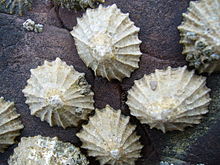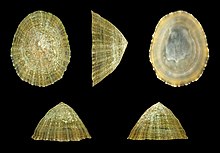Patella vulgata
| Patella vulgata | |
|---|---|

| |
| Live Patella vulgata on a rock in Wales | |

| |
| Shell of Patella vulgata | |
| Scientific classification | |
| Domain: | Eukaryota |
| Kingdom: | Animalia |
| Phylum: | Mollusca |
| Class: | Gastropoda |
| Subclass: | Patellogastropoda |
| Family: | Patellidae |
| Genus: | Patella |
| Species: | P. vulgata
|
| Binomial name | |
| Patella vulgata | |
| Synonyms[1] | |
| |
Patella vulgata, common name the common limpet or common European limpet[2] is a species of sea snail. It is a typical true limpet; a marine gastropod mollusc in the family Patellidae, with gills.[1] This species occurs in the waters of Western Europe.
Radula
[edit]The radula in this species is longer than the shell itself. It contains 1,920 teeth in 160 rows of 12 teeth each. Patella vulgata is found attached to firm substrates from the high shore to the edge of the sublittoral zone, although it predominates in areas of wave action. Its shell is conical, up to around 6 cm long, and lacks defined chirality. Common limpets are believed to be able to live for up to twenty years.[3]
Patella vulgata has been the focus of a range of scientific investigation, as far back as 1935.[4] Its development is well described[5] and it has been the focus of transcriptomic investigation, providing a range of genomic sequence data in this species for analysis.[6]
Their teeth are the strongest natural material known. A study published in the Royal Society journal in 2015 concluded that "the tensile strength of limpet teeth can reach values significantly higher than spider silk, considered to be currently the strongest biological material, and only comparable to the strongest commercial carbon fibres.” The material was able to withstand 4.9 GPa. This considerable tensile strength of limpet teeth is attributed to a high mineral volume fraction of reinforcing goethite nanofibres.[7][8][9][10][11]

Human consumption
[edit]The common limpet was formerly eaten in Ireland, especially during times of hunger such as the Great Famine of 1845–50; it was known to be very tough and had to be thoroughly boiled or roasted to be edible.[12] One Irish proverb said that "Mussels are the food of kings, limpets are the food of peasants."[13] Tomas O'Crohan described eating them in his memoir The Islandman.[14] They are also consumed in Asturias in Spain under the name "Llampares" and in Portugal under the name "Lapas".
See also
[edit]Gallery
[edit]-
Shells of the common limpet from Wales
-
Patella vulgata in litoral of Finistère, near Porspoder - the region affected by the Amoco Cadiz tanker disaster in 1978
-
Drawing of the soft body and underside of the shell of Patella vulgata; a) foot b) fringed mantle c) tentacles d) mouth e) eyes f) gills
-
Photograph of the soft body and underside
-
Radula of Patella vulgata; a) median teeth b) laterals c) uncini or marginals
-
Remains of a human meal, limpet shells from Cantabrian Lower Magdalenian layer of the Altamira cave. - MHNT
-
Patella vulgata in its natural habitat.
References
[edit]- ^ a b Gofas, S. (2014). Patella vulgata Linnaeus, 1758. Accessed through: World Register of Marine Species at http://www.marinespecies.org/aphia.php?p=taxdetails&id=140685 on 2014-10-29
- ^ "Edible Molluscs Page 6". www.manandmollusc.net.
- ^ "Limpets". BritishSeaFishing.co.uk. 15 October 2012. Retrieved 24 January 2014.
- ^ Smith, F (1935). "The Development of Patella vulgata". Philosophical Transactions of the Royal Society of London. Series B, Biological Sciences. 225 (520): 95–125. Bibcode:1935RSPTB.225...95S. doi:10.1098/rstb.1935.0008.
- ^ Damen, Peter; Dictus, Wim J.A.G. (1994). "Cell Lineage of the Prototroch of Patella vulgata (Gastropoda, Mollusca)". Developmental Biology. 162 (2): 364–383. doi:10.1006/dbio.1994.1094. PMID 8150201.
- ^ Werner, Gijsbert D. A.; Gemmell, Patrick; Grosser, Stefanie; Hamer, Rebecca; Shimeld, Sebastian M. (2013). "Analysis of a deep transcriptome from the mantle tissue of Patella vulgata Linnaeus (Mollusca: Gastropoda: Patellidae) reveals candidate biomineralising genes". Marine Biotechnology. 15 (2): 230–243. Bibcode:2013MarBt..15..230W. doi:10.1007/s10126-012-9481-0. PMID 22865210. S2CID 1836313.
- ^ Asa H. Barber; Dun Lu & Nicola M. Pugno (2015). "Extreme strength observed in limpet teeth". Journal of the Royal Society Interface. 12 (105). Royal Society journal: 20141326. doi:10.1098/rsif.2014.1326. PMC 4387522. PMID 25694539.
- ^ Webb, Jonathan. "Limpet teeth set new strength record" BBC News, 18 February 2015. Archived February 18, 2015, at the Wayback Machine
- ^ "Sea Snail Teeth Top Spider Silk as Strongest Material on Earth". NBC News. 18 February 2015.
- ^ "Limpet teeth 'strongest material ever'". BBC News.
- ^ "Limpet teeth rewrite record books". BBC News.
- ^ Enright, Damien (August 18, 2008). "Enjoying a tasty treat from the salty sea". Irish Examiner.
- ^ "Slainte! Alive, Alive-Oh! | Irish America". 17 February 2011.
- ^ Crohan, Tomás Ó (June 28, 1978). The Islandman. Oxford University Press. ISBN 978-0-19-281233-9 – via Google Books.
- Linnaeus, C. (1758). Systema Naturae per regna tria naturae, secundum classes, ordines, genera, species, cum characteribus, differentiis, synonymis, locis. Editio decima, reformata. Laurentius Salvius: Holmiae. ii, 824 pp.
- Lespinet, Nederbragt, Cassan, Dictus, Van Loon, et al. Characterisation of two snail genes in the gastropod mollusc Patella vulgata. Implications for understanding the ancestral function of the snail-related genes in Bilateria. 2002.
External links
[edit]- Entry in Encyclopedia of Life
- MarLIN species information
- Live underwater image
- BBC Info retrieved 2012
- FSC Info- great pix Retrieved 2012
- Photos of Patella vulgata on Sealife Collection







